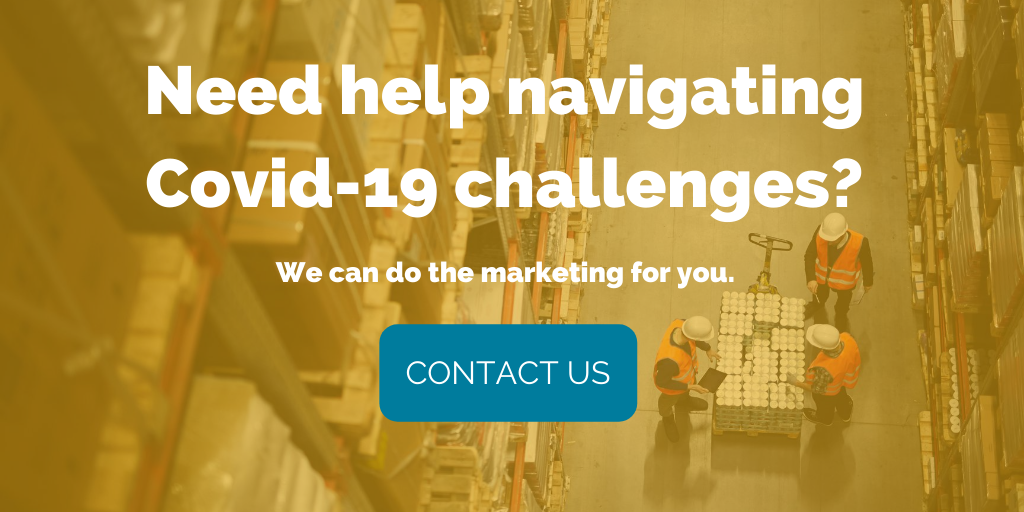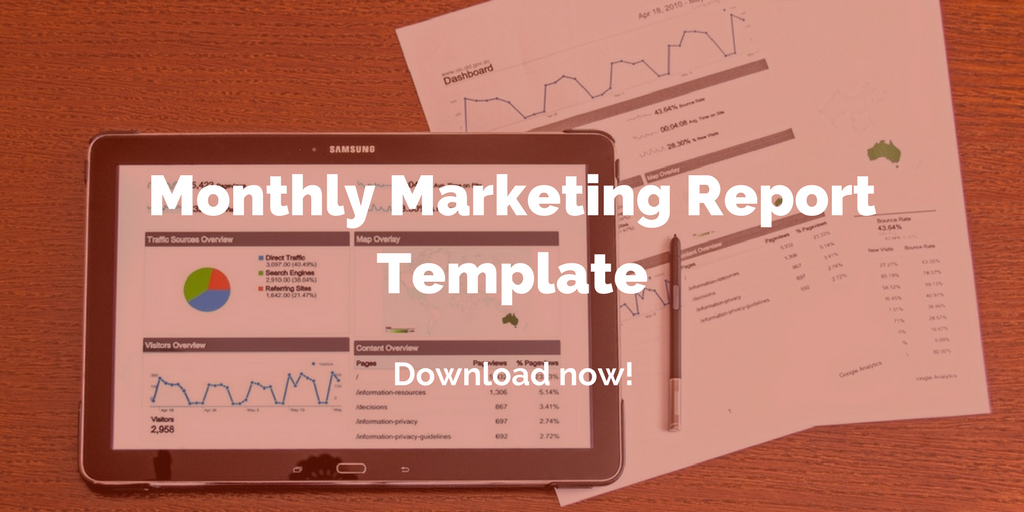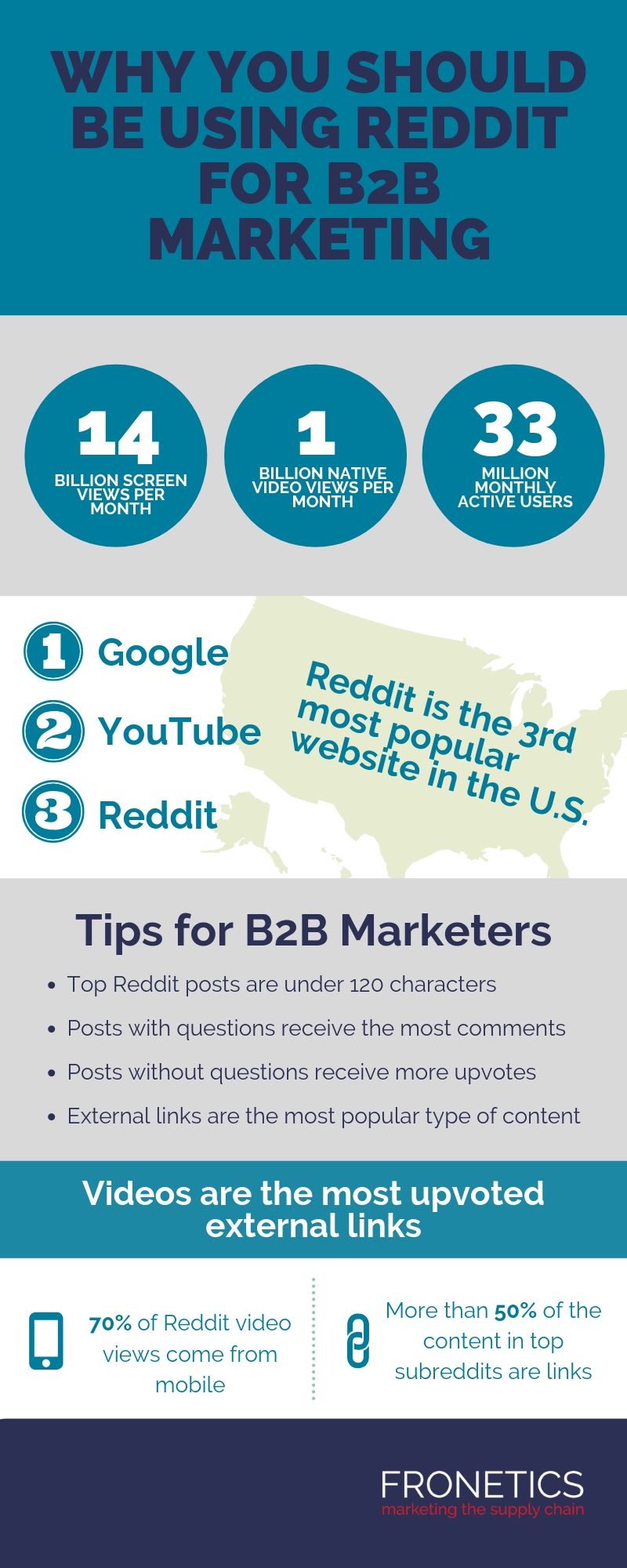
by Fronetics | Jun 9, 2020 | Blog, Content Marketing, Covid-19, Marketing, Strategy, Supply Chain
Too busy? Don’t want to invest in-house? Here are 4 prime reasons organizations opt to outsource content marketing.
No other lead generation tactic is more important to technology marketers than content assets. The new Gartner research — trade shows come in second place — shows the importance of paying heavy attention to how your organization positions itself online. If the Covid-19 repercussions left you no choice but to cut back on marketing or if you have been juggling more than ever, consider the case for outsourcing content marketing to stay competitive and excel.
At a time when some of the biggest supply chain trade shows have been either canceled or postponed, count on content assets to grow in significance. Is your organization up to the task?
In our work with both supply chain startups and multi-national corporations, we have noted a few returning reasons for outsourcing content marketing.
Do you recognize yourself or your organization in any of the following?
Outsourcing content marketing: 4 reasons organizations decide to seek outside help
Too much to do
When content marketing is the umpteenth task on an endless to-do list, the results will suffer. This scenario is particularly common among startups where everyone is wearing as many hats as possible in anticipation of the next round of funding. The haphazard approach to what is being published on social channels and on the blog does the company no favors and leaves the person in charge — frequently with limited marketing experience — feeling frustrated. Instead of letting keyword-optimized content carve out a brand niche and build website SEO, the effort goes nowhere although the will to succeed is strong.
The alternative: Partner with a content marketing agency and turn the focus on your core expertise.
No consistency
The effectiveness of content marketing relies on consistency. But being consistent is a major challenge for supply chain companies, especially when trying to recover from months of unprecedented disruption. As we explained in this post, consistency feeds SEO. Let it slip, and you lose in the online search race. In this case, sudden trade show cancelations may have forced the in-house marketing team to a quick pivot, from executing the company marketing strategy to pouring all efforts into making trade show contingency plans. Add a product launch to the mix and chances are content production will come to a standstill.
The alternative: Keep SEO humming and your online presence strong with an outsourced marketing team invested in your success.
Desire to scale but costs are too high
Needs can arise quickly. There may be a trend that a company wants to jump on or a sudden change in the business environment that warrants the need to scale up content marketing quickly. Several of our clients have sought out Fronetics because they lacked certain marketing capabilities and did not necessarily want or have the resources to make the investment in-house. That is particularly true under current circumstances when some organizations are battling budget constraints and disruption. If an organization wants to capitalize on video marketing, for instance, it can be both time-consuming and costly to train team members or go through a rigorous hiring process.
The alternative: Leverage a team out outsourced content experts to fill the gap without adding fixed costs.
Lack of analysis
The motions of content marketing are repetitive — researching, strategizing, executing, analyzing, revising — but they are so for a reason. Even the most well-intentioned content strategy can fail when an organization does not act on analytics. But for busy organizations, it is not uncommon for those last pieces of the puzzle — analyzing and revising — to be left undone.
What types of content worked well this quarter? How did the email messaging fare? What was the click-through-rate? During the past few months, when disruption ruled, it is hardly surprising if not every step was optimally performed. Yet, it can all the same be damaging to the overall success of the marketing effort if the metrics are allowed to go unnoticed for too long.
The alternative: Let content count with an outsourced marketing team that constantly needs to prove ROI.
Considering the significance of content assets, it pays to do it well. Is outsourcing content marketing right for you?

Read more:

by Fronetics | May 19, 2020 | Blog, Covid-19, Current Events, Marketing, Strategy, Supply Chain
From answering the most important question to humanizing your company, make it part of your Covid-19 messaging strategy.
If your organization put marketing on pause to deal with the impact of Covid-19, it is time to recharge — thoughtfully. But what should your Covid-19 messaging strategy look like? What should you say and where should you say it?
More than any other industry, Covid-19 thrust the supply chain into the eye of the storm. Now, after a few months of intense disruption, a new normal has set in, giving companies in every supply chain vertical a chance to evaluate how to best position their business at a time of great uncertainty.
Since supply chain partnerships are rarely forged overnight, consider the benefits of not only looking after current clients and stakeholders but also extending a hand to new leads. Faced with unprecedented challenges themselves, these potential prospects may be searching for solutions just like yours.
Question is: What will they find when they come across your website and social channels?
Let’s take a closer look at the key components of a Covid-19 messaging strategy for supply chain companies.
Answer the No. 1 question
Yes, you are open for business. Make it clear on the homepage and update your social media profile with the latest facts. Do not let visitors go searching for that one piece of vital information. Although the immediate urgency and upheaval of the first few weeks of the pandemic is waning, the economic repercussions are just starting to be felt, and the question of whether your organization is still in business needs a quick answer. A pop-up message or banner will get the job done. Include a CTA that leads to a landing page on your organization’s Covid-19 response.
Create a dedicated landing page
What is your organization doing to protect employees and clients? Are you experiencing any service interruptions? Do you serve shelter-in-place areas? The landing page can answer all of those questions. Consider the landing page a resource for your clients and prospects. It may include the company crisis communications plan, a direct message from a company executive, links to helpful resources, and more.
Pick the right topics
Like many others, you may have published an initial statement on the crisis and your dedication to helping clients navigate through it. Where do you go from here? Sounding salesy or overly eager to promote your own supply chain solutions can come across as desperate. And moving on like nothing has happened will likely strike visitors as detached.
Take the perspective of your current clients and prospects — what do they want to know about your services at this time? Their priorities have undoubtedly changed since last year.
Many supply chain companies are uniquely positioned to talk about themselves since they truly are part of the solution to the disruption of goods and services. A provider of flexible warehouse space can publish a post on the importance of building a resilient supply chain that can sustain the impact of unexpected events. And an IoT leader may discuss how its fleet app can keep overworked drivers safe.
The voice of the company should echo throughout your site. Update wording that may seem inappropriate or out of place now. Speak with clarity and authority. Give prospects a sense that you really understand what they are going through (because you do). And, most of all, keep publishing relevant content. A dormant blog or resource page sends the wrong message.
Humanize the company
Being able to connect on a personal level with businesses is gaining in significance. Even in the B2B space, it is a strategy that has worked well for many of our clients. This is even more true during a crisis with such a devastating toll on public health as Covid-19.
We have seen CEOs step up to speak directly on camera to clients or let themselves be interviewed about the company’s crisis response. Team members can be featured, too, in video snippets, showcasing any PPE donations or in-the-field work. Videos and personal stories also tend to foster engagement on social media. Again, keep the tone and content aligned with your target audience.
Final word
Your Covid-19 messaging strategy can have a big impact. Think tactful and empathetic. Stay active and engaged. We know this is a challenging time for so many. Getting your messaging right is a good place to start.


by Fronetics | May 6, 2020 | Blog, Content Marketing, Covid-19, Current Events, Marketing, SEO, Strategy, Supply Chain
So much to say, so little time. Supply chain marketing during Covid-19 — leaning in is better than backing out.
Turmoil does not quite begin to describe the situation that supply chain companies have experienced lately. The Covid-19 pandemic threw in just a few weeks the finely calibrated, just-in-time supply chains into a state of disarray. In the midst of the struggle to get product from Point A to Point B — while also ensuring the health and safety of employees — many companies had little choice but to adopt an all-hands-on-deck approach.
We saw it ourselves as our clients were suddenly buried in challenges that only weeks earlier had posed no issues at all — securing electronic parts overseas, locating warehouse space, finding freight forwarders, moving product out of port, and more.
If supply chain marketing during Covid-19 had to take a backseat during the initial phase of the crisis, beware of staying quiet for too long. Letting your marketing channels sit idle for an extended period, or drastically scaling back at a time when communication matters more than ever, is not a risk-free strategy.
Let us explain why:
Covid-19 supply chain marketing: Lean in or risk losing ground
Go silent — or stay strong
In the wake of the first shockwaves of the Covid-19 pandemic, supply chain companies understandably had to devote extensive resources to regain their footing. Few industries felt the impact as deeply as the supply chain. For some, the disruption opened up a flood of new business, sending the entire organization scrambling to keep up. For others, it meant every budget line item had to be scrutinized.
At the same time, we noted another challenge brewing for busy organizations: Maintaining a strong online presence during a tumultuous time. How do instill confidence in current customers and gain new leads if you say little or nothing at all?
After the first flurry of crisis-related marketing emails that many of us received (“We are here to help”), some companies — overwhelmed by the scope of work — let their social media accounts go silent and blog pages seized being updated.
The risk? Taking a break or withdrawing altogether could put your organization in a worse position later.
A McKinsey study underscores this point — conventional downturn strategies can actually hamper recovery. The performance analysis of 700 high–tech companies during two decades of market contractions showed “making obvious moves (for instance, cutting costs) as well as counterintuitive ones (such as increasing sales and marketing expenditures) quickly can improve a company’s position when the recovery begins.”
Interestingly, the best-performing companies increased their marketing and advertising spend relative to their competitors, but also compared to their own spending when times were better. However, from our perspective, the issue is far from just spend but identifying the most effective marketing channels and tactics at a time when resources may be scarce.
Weaken SEO — or make it soar
The risk of cutting back on supply chain marketing during Covid-19 also extends to search engine optimization (SEO). Rather than a one-time project, SEO needs constant attention to hum. It is the foundation of your effort to improve the quality and quantity of unpaid website traffic by increasing the visibility of your site or page to search engine users.
SEO and content go together
The completion of a well-designed website is only the beginning. If there is anything SEO demands more than anything else, it is content. You simply cannot ace one without the other. New, key-word optimized content is what makes SEO tick. Google Search has for years used a freshness algorithm to index pages. This means fresh content gets rapidly indexed and lands higher in search rankings than older content.
Backlinks — other reputable sites linking to your content — are also crucial to building SEO. When you provide up-to-date, insightful content, chances increase others will notice and link back to your site, especially during a time when so many are online searching for information. The same goes for backlinks and traffic to your site generated by social media.
So, what is the risk of going quiet?
The short of it: SEO can suffer. If content was the backbone of your marketing strategy before the pandemic hit, your organization has likely established a history of domain authority and is, as a result, in a better position to weather the storm. But not even the best of sites can escape the reality of what matters to search engines. Although you can still squeeze juice out of old keywords, lack of new content puts your organization at a disadvantage when search engines evaluate your pages in competition with countless others.
So much to say — can you find the time?
In many respects, supply chain marketing during Covid-19 comes down to this: Who would you want to do business with during a time of great uncertainty? What signals do you want to send to your audience? What do you want to tell them? As challenging as it may be, leaning in is better than backing out.


by Fronetics | Oct 8, 2019 | Blog, Content Marketing, Logistics, Marketing, Supply Chain
Digital marketing helps increase brand awareness, convert leads, and drive measurable business value. But that doesn’t mean it’s always easy to execute. Here are 4 digital marketing failures and how to get back on track.
Highlights:
- While digital marketing is extremely effective, proving ROI is often the top challenge for marketers.
- If your content isn’t SEO-friendly, readers may not even have the chance to see what you’re writing because it is so far down in their search results.
- Though it’s often more time consuming than written content, visual content, including infographics and video, are the most popular form of content right now.
B2B buyers want information, and they’re inundated with it. Are you ready for this? There are 2.5 quintillion bytes of data created each day, and that number is only accelerating with the growth of the Internet of Things (IoT). Over the last two years alone, 90% of the data in the world was generated.
Because of at its core it leverages data to target audiences, digital marketing has been a successful solution for marketers. But it’s not that easy.
Here at Fronetics, we’re big believers in analytics. And while digital marketing is extremely effective, proving ROI is often the top challenge for marketers. Without data to back up your efforts, how do you prove your digital marketing strategy is working? And with all those quintillion bytes of data being created every day, how do you stand out from competitors?
The simple answer is using analytics to evaluate your efforts and to determine what is working and what needs to be tweaked. Digital marketing strategies have to be fluid and easily adaptive to change. Companies have to grow and shift with the times, which means that marketing plans have to evolve.
Here are four digital marketing failures, which you can easily identify through analytics, and how to fix them.
4 digital marketing failures (and how to make them right)
1.Lack of strategy
Many marketers understand the power of digital marketing but think they can jump in without a strategy. And not just a strategy that you thought of over coffee, but an actual documented strategy. Why? Because a documented digital marketing strategy will help you work smarter and more effectively.
In fact, according to the Content Marketing Institute, those with a documented content marketing strategy:
- Are far more likely to consider themselves effective at digital marketing
- Feel significantly less challenged with every aspect of digital marketing
- Generally, consider themselves more effective in their use of all digital marketing tactics and social media channels
- Were able to justify spending a higher percentage of their marketing budget on content marketing
Having a fundamental understating of your digital marketing plan and a strategy for executing that plan is crucial for success.
2. No search engine optimization
Google is responsible for 94% of total organic traffic. That’s almost ALL organic traffic. SEO means creating content for your digital assets so they will be prioritized by Google in search queries related to your brand or products. It’s time for digital marketers to learn the basics of Google’s algorithms and understand how the content they’re creating can rank better against the competition.
61% of marketers say improving SEO and growing their organic presence is their top inbound marketing priority. If your content isn’t SEO-friendly, readers may not even have the chance to see what you’re writing because it is so far down in their search results.
3. Quality is lacking
While this seems obvious, it’s worth repeating. If the quality of your content is bad, no one will read it, regardless of what value it offers. The same goes for content about which you find yourself saying, “it works,” or “it’s fine!” If there are 27 million options, who would choose “fine?”
Do an honest evaluation of your digital assets, or have a neutral outside party do so for you. Is it original, informative, and well-written? Make sure that your copy is edited, and that it is free from grammatical errors, spelling mistakes, and awkward phrasing. If you want people to read your content, you should make sure that it’s worth reading.
And don’t shy away from visual content. Though it’s often more time consuming than written content, visual content, including infographics and video, are the most popular form of content right now.
4. Lack of posting consistency
Inconsistently publishing content is one of the primary reasons readers become disengaged with a particular brand. Having consistent, high-quality content helps establish your company as a thought leader in your industry. Even publishing one more blog post a week can significantly boost your readership.
Try experimenting with the amount of content you publish per week. For example, if you currently publish two times a week, try bumping it up to three times for one month. The following month, maybe you try bumping it to four. You’ll find your sweet spot when you’re increasing engagement but are still able to handle the production schedule and it’s not impacting the quality of your content.
What other digital marketing failures have you encountered?
Related posts:


by Fronetics | Oct 2, 2019 | Blog, Content Marketing, Logistics, Marketing, Social Media, Supply Chain
Our infographic gives you everything from the basics to the specifics of using Reddit for B2B marketing.
Highlights:
- Reddit is a social platform made up of thousands of individual forums where users can post content and vote on its relevance and value.
- The first rule of Reddit: avoid overt brand promotion and sales pitches.
- Creating your own subreddit is the best way to make Reddit a high-value marketing channel.
Reddit calls itself the “frontpage of the internet.” And for good reason. The social networking site boasts over 300 million active users, as well as 140,000 active communities and a whopping 14 million pageviews per month. However, when it comes to using Reddit for B2B marketing, it’s still a relatively untapped channel.
Our infographic is your ultimate guide to using Reddit for B2B marketing. Read on to find out more about this platform and how you can put it to work for your business.
What is Reddit?
Since the site was founded in 2005, Reddit’s user base has skewed young. However, as millennials come of age and rise to positions of influence within the B2B purchasing landscape, Reddit is becoming an increasingly effective way to reach your target audience.
At its most fundamental level, Reddit is a social sharing website built around users submitting links, pictures, and text, which the community can then vote on. Similarly to Quora, the content that’s voted as best rises to top visibility, while downvoted content becomes less visible.
The structure of the site resembles an intricate message board, divided up into hundreds of thousands of subfolders, called “subreddits,” which function as specific forums. Imagine just about any topic you can think of, and there’s probably a subreddit for it. In fact, for thinking about Reddit for B2B marketing, the following subreddits could be of interest:
If you’re looking for industry discussion on a specific marketing topic, it’s likely you can find a relevant subreddit. While each subreddit has different moderators and regulations, there’s one common thread that runs through the entire site: there is a premium placed on authentic content and interactions – and a disdain for overt self-promotion.

(Made with Canva)
Using Reddit for B2B marketing in 5 steps
Now that we’ve covered the basics about what Reddit is and how it works, let’s talk about how to make it part of your marketing strategy.
Step 1: Determine your target subreddit(s).
In the same way that a good digital marketing strategy begins with identifying your target audience, determining your target subreddits is the starting point for successfully using Reddit for B2B marketing. While the massive quantity of subreddits can be overwhelming, consider the following three questions to zero in on the right subreddits for your business:
- Does the subreddit relate to your business’ brand or products, as well as any specific keywords that shape your digital marketing strategy?
- How large is each subreddit’s audience? (Note: bigger isn’t necessarily better. A larger audience has the potential to generate more traffic, but it’s easier to establish your brand’s presence in a smaller subreddit.)
- How much engagement does the subreddit generate?
Once you’ve determined a few relevant subreddits with various audience sizes and high engagement, you’re ready to begin posting.
Step 2: Post links… to websites other than your own.
Before you start wondering why we’re encouraging you to promote other pages, there’s another facet of Reddit to consider. The platform takes the idea of Karma to a literal level. On Reddit, your reputation is referred to as your “Karma score,” and it’s determined by your level of positive participation on Reddit, measured by the number of upvotes you receive. As your Karma score rises, your posts become more visible.
One of the most effective ways to boost your Karma score, particularly when you’re starting out, is to post links to content that the subreddit community finds relevant and generate conversation. It’s important to make sure you don’t repost content that another member of your subreddit has already posted, as duplicates can hurt your Karma score.
Step 3: Share valuable content… that’s not a sales pitch.
When posting content to your target subreddits, the path to success is quite simple. Post content that offers value to the community. This means engaging in discussions, asking and answering questions, and, at all costs, avoiding blatant sales pitches.
Sam Holzman of ZoomInfo explains it this way: “Sharing a link to a product page will signal that you’re a marketer who wants to promote products, not an engaged community member. On the other hand, a blog post about the benefits of a particular product will be more useful to your fellow community members and, as a result, is more likely to be upvoted and commented on.”
Step 4: Advertise on Reddit.
While blatant sales pitches on Reddit are a sure way to a low Karma score, the platform does offer its own native advertising. Similar to Facebook and Twitter, Reddit Advertising is a relatively inexpensive way to boost the visibility of your content on the platform. However, it’s important to note that Reddit doesn’t offer the type of analytics as Facebook and Twitter.
Sponsored posts on Reddit appear at the top of targeted subreddits for a specified duration. You pay for duration as well as the number of impressions you receive. Sponsored posts look like any other Reddit posts. Advertising on the platform isn’t necessary for success, but it can help establish a visible presence, particularly at first.
Step 5: Create a subreddit.
Creating a subreddit isn’t easy – it requires a significant time investment to start and maintain. However, doing so is the best way to turn Reddit into an extremely valuable marketing channel. Once you’ve established your presence, creating a branded subreddit gives your customers and prospects a forum to interact, with you and with each other.
Particularly at the outset, you’ll likely need to promote your subreddit on other platforms. Post links to it on your other digital assets, and you could even offer an incentive for engaging on your subreddit.
Your branded subreddit is also an ideal place to offer customer service. Holding exclusive Q&As, referred to on Reddit as AMAs (“Ask Me Anything”), is another effective strategy to drive traffic and engagement on your subreddit.
The bottom line on Reddit for B2B marketing
Reddit is a rich resource for marketers and a fertile ground for marketing your brand and products. The platform is best thought of as a place to share and engage with high-quality, valuable content, rather than as a place for overt promotion. Effectively using Reddit for B2B marketing requires an investment of time and energy, but the results can be well worth the effort.
Related posts:










